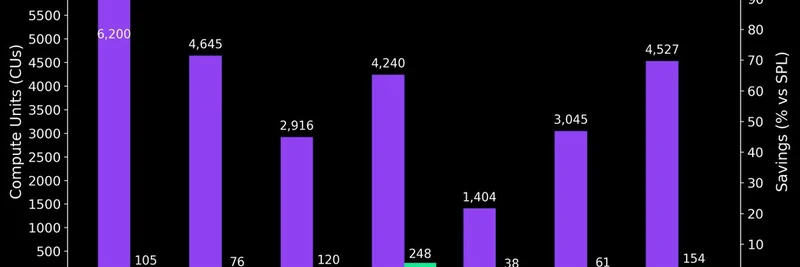Hey folks, if you're deep into the Solana ecosystem like I am, you've probably seen the buzz around the latest upgrade that's set to make things a whole lot smoother. A recent tweet from Solana Daily highlighted Anza's introduction of SIMD-0266, the Efficient Token Program. This isn't just some minor tweak—it's a game-changer that replaces the old SPL Token program with something called P-Token, cutting down compute unit (CU) consumption by up to 98%. For those not in the know, CUs are basically the "gas" on Solana, measuring how much computational power a transaction uses. Lower CUs mean cheaper, faster ops, and more room in each block for transactions.
The chart from the tweet says it all: for common instructions like TransferChecked, P-Token uses just 105 CUs compared to SPL's whopping 6,200—that's a 98% drop! Similar savings show up across the board, from initializing accounts to syncing natives. This upgrade, proposed back in March via SIMD-0266 on GitHub, is all about efficiency without breaking anything.
What Exactly is P-Token?
P-Token is a drop-in replacement for the SPL Token program, built by the team at Anza. It uses a nifty library called Pinocchio (that's where the "P" comes from), which optimizes how programs handle data on Solana. Instead of copying memory around, it accesses stuff directly via pointers—think zero-copy magic. It's also "no_std," ditching Rust's standard library to keep things lean and mean. The result? A smaller program binary and massive CU reductions.
This isn't a new token standard; it's fully compatible with existing SPL tokens. Your wallets, DEXs, and apps won't notice the switch—they'll just run better. As Helius explains in their deep dive, P-Token mirrors the exact instructions and account layouts of the old program, so no code changes needed.
Breaking Down the Efficiency Gains
Let's get into the numbers because they're impressive. Based on real-world data, token instructions eat up about 10% of Solana's block space. P-Token shrinks that to 0.5%, freeing up 9.5% more capacity for other stuff. That's like adding extra lanes to a highway without rebuilding the road.
Here's a quick table of CU savings for some key instructions:
| Instruction | P-Token CUs | SPL-Token CUs | Savings |
|---|---|---|---|
| TransferChecked | 111 | 6,200 | 98% |
| Transfer | 79 | 4,645 | 98% |
| CloseAccount | 125 | 2,916 | 96% |
| InitializeAccount3 | 248 | 4,240 | 94% |
| InitializeImmutableOwner | 38 | 1,404 | 97% |
| SyncNative | 62 | 3,045 | 98% |
These are the most-used ops, making up the bulk of token activity. For meme tokens, which often see wild trading volumes with tons of transfers and account creations, this means transactions zip through faster and cost less in fees. Imagine pumping a hot new meme without getting bogged down by network congestion.
Why This Matters for Meme Tokens
At Meme Insider, we're all about those viral, community-driven tokens that thrive on Solana's speed. Meme coins like BOOK OF MEME ($BOME) are perfect examples—they rack up millions of transfers weekly. With P-Token, we're looking at up to 19x efficiency gains, which could handle even bigger pumps without the network grinding to a halt.
Weekly stats show Solana creating 200,000–300,000 new SPL tokens and processing over 650 million transfers. That's exploded from last year, thanks to the meme craze. Lower CU usage means more transactions per block, better composability for DeFi protocols (like those AMMs where memes often launch), and even new features like batch instructions to bundle ops and save more CUs. For builders and traders, it's a win-win: cheaper bots, smoother swaps, and more room for innovation.
Backwards Compatibility and Rollout
Worried about disruption? Don't be. P-Token has been audited by firms like Neodyme and Zellic, with formal verification ongoing. They replayed months of mainnet transactions to confirm identical outputs. The rollout? It'll go through a validator vote, then swap in at an epoch boundary using Solana's upgradable loader. No manual migrations required.
Plus, it adds handy new instructions: withdraw excess lamports (recovering over $36 million in stuck SOL from mint accounts, including $BOME's chunk), batch processing for efficiency in complex trades, and unwrap lamports for wrapped SOL without extra accounts.
Looking Ahead: Solana's Scalability Boost
This upgrade fits right into Solana's roadmap, aiming for 100 million CUs per block by next year. Combined with other tweaks, it could make the network 20x more efficient overall. For the meme community, it means sustaining those epic rallies without the lag we've seen in past bull runs.
If you're building or trading memes on Solana, keep an eye on this—it's the kind of under-the-radar tech that powers the next big wave. Head over to Anza's site or the original proposal for the nitty-gritty. What do you think—will P-Token spark the next meme supercycle? Drop your thoughts below!



